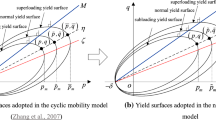Abstract
Classical soil constitutive models fail to describe the strain-softening response of cemented soil at a low stress level. This paper proposes a constitutive model that incorporates the Modified Cam Clay model to describe pressure-dependent soil stiffness and strength corresponding to volume changes into (1) empirical functions to recognize the mobilized friction and initial cementation as evolutions of the deviatoric plastic strain and (2) a power-type compressibility function to track the effective stress-dependent volumetric response. In this case, the no additional complexity related to the model formulation is added. The cement-treated constitutive model is implemented to simulate the drained triaxial test. The results indicate that the initial state of isotropic stress and the cement degradation rate defines the stress–strain-volume response, whereas the deviatoric stress eventually approaches the critical state strength.



Similar content being viewed by others
References
Chong S-H, Santamarina JC (2016) Soil compressibility models for a wide stress range. J Geotech Geoenviron Eng 142(6):06016003
Coop MR, Atkinson JH (1993) The mechanics of cemented carbonate sands. Géotechnique 43(1):53–67
Cuccovillo T, Coop MR (1999) On the mechanics of structured sands. Géotechnique 49(6):741–760
Gens A, Potts DM (1988) Critical state models in computational geomechanics. Eng Comput 5(3):178–197
Horpibulsuk S, Liu MD, Liyanapathirana DS, Suebsuk J (2010) Behaviour of cemented clay simulated via the theoretical framework of the structured cam clay model. Comput Geotech 37(1):1–9
Huang JT, Airey DW (1998) Properties of artificially cemented carbonate sand. J Geotech Geoenviron Eng 124(6):492–499
Kasama K, Ochiai H, Yasufuku N (2000) On the stress–strain behaviour of lightly cemented clay based on an extended critical state concept. Soils Found 40(5):37–47
Leroueil S, Vaughan PR (1990) The general and congruent effects of structure in natural soils and weak rocks. Geotechnique 40(3):467–488
Nguyen LD, Fatahi B, Khabbaz H (2014) A constitutive model for cemented clays capturing cementation degradation. Int J Plast 56:1–18
Nova R, Castellanza R, Tamagnini C (2003) A constitutive model for bonded geomaterials subject to mechanical and/or chemical degradation. Int J Numer Anal Methods Geomech 27(9):705–732
Robin V, Javadi AA, Cuisinier O, Masrouri F (2015) An effective constitutive model for lime treated soils. Comput Geotech 66:189–202
Schnaid F, Prietto PDM, Consoli NC (2001) Characterization of cemented sand in triaxial compression. J Geotech Geoenviron Eng 127(10):857–868
Trhlíková J, Mašín D, Boháč J (2012) Small-strain behaviour of cemented soils. Géotechnique 62:943–947
Acknowledgements
This paper was supported by Sunchon National University Research Fund in 2018.
Author information
Authors and Affiliations
Corresponding author
Additional information
Publisher's Note
Springer Nature remains neutral with regard to jurisdictional claims in published maps and institutional affiliations.
Appendix: Mathematical Formulation of the Constitutive Model
Appendix: Mathematical Formulation of the Constitutive Model
A summary of the proposed constitutive model is presented here. The plastic strain increments are employed following standard procedures of the theory of hardening plasticity.
1.1 Elasto-plastic Constitutive Relation
The general consistency equation related to the state parameter can be expressed as follows:
Here σ (p′c and p′cto) is the stress state parameter updated with the evolution of the yield surface and the state parameter α is characterized by the plastic deformations consisting of the plastic multiplier δχ and hardening function h:
By inserting Eq. (11) into Eq. (10), the consistency equation can be reformulated with the hardening modulus H:
The elastic constitutive relation can be expressed by the elastic constitutive matrix and plastic strain:
Inserting the stress increment from Eq. (12) into the constitutive relation Eq. (13), the plastic multiplier can be derived:
The continuum tangent modulus related to incremental stress and strain level is derived with the plastic multiplier that involves the hardening response and variation of state parameter
By taking the derivatives of yield function into account with the stress state parameters, several components of the constitutive matrix can be defined:
Thus, the components of hardening modulus H can be determined with the following equation:
Rights and permissions
About this article
Cite this article
Chong, SH. Development of Constitutive Model for Simulation of Cemented Soil. Geotech Geol Eng 37, 4635–4641 (2019). https://doi.org/10.1007/s10706-019-00903-3
Received:
Accepted:
Published:
Issue Date:
DOI: https://doi.org/10.1007/s10706-019-00903-3




